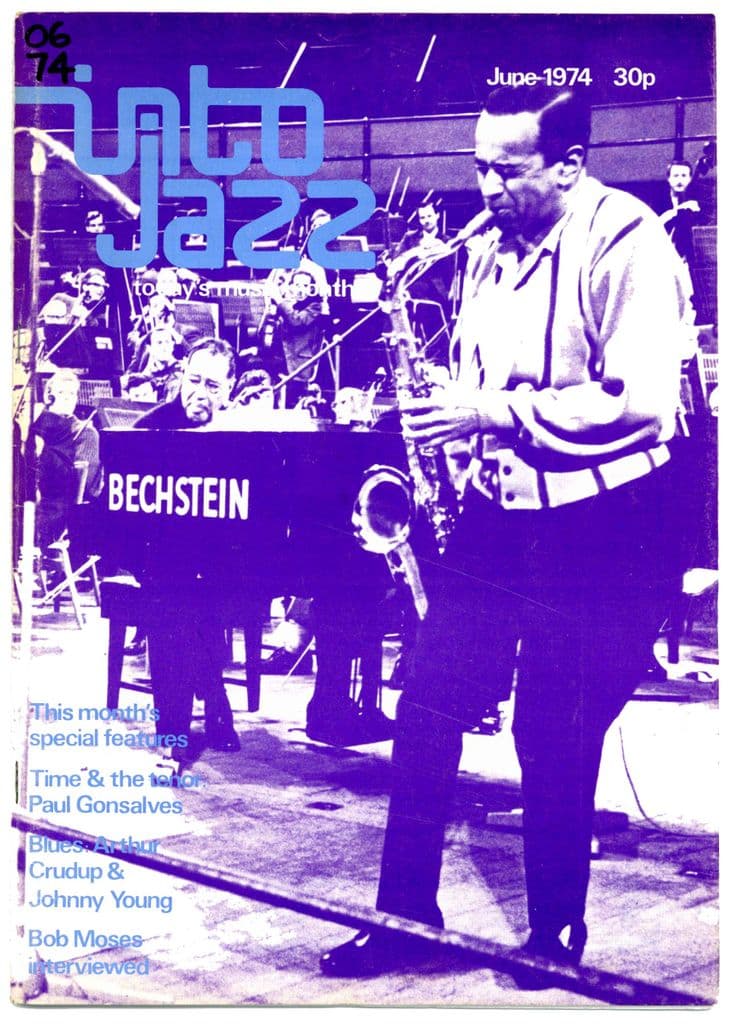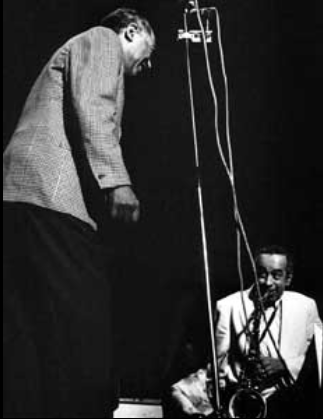 This article originally appeared in the June 1974 edition of the magazine Into Jazz (Vol. 1, No 5).
This article originally appeared in the June 1974 edition of the magazine Into Jazz (Vol. 1, No 5).
Unfortunately, a number of mistakes were introduced to the text as a result of editorial errors. We are delighted to present here a verbatim reproduction of the corrected version, recently printed by the UK Duke Ellington Society and kindly supplied by the author Graham Colombé himself.
PAUL GONSALVES 1920-74
by Graham Colombé
Ed: Frank Harvey brought to my attention this appreciation of Paul Gonsalves, written by Graham Colombé at the time of Paul's death in London in May 1974 for the June 1974 issue of Into Jazz. When I contacted Graham he explained that he had written it as a postscript to Time And The Tenor, an earlier two-part article about Lester Young and Coleman Hawkins. Hence the original title, Time And The Tenor Postscript: Paul Gonsalves 1920-74, and the references to Hawk and Prez. We’ll dispense with the postscript bit and reprint here this perceptive and authoritative appreciation of a master tenor player who is still too often taken for granted, but who in 1974 Graham had no hesitation considering alongside the instrument’s greatest innovators.
I’m also very pleased to use once more Sefton Samuels’ fine photograph of Paul and Duke. It goes perfectly with Graham’s closing paragraph.
This sad and unplanned extension of the original article is a consequence of the sudden death of Paul Gonsalves in London on 15 May. His early demise, at the age of 53, has obvious enough connections with those of Young and Hawkins and anyone who saw him at the Rainbow last year must have realised that the end was close. Unlike Young and Hawkins however, Gonsalves enjoyed during the last quarter-century of his life an established position with the band leader whose music he loved, and an appreciative audience throughout the world. It appeared therefore that artistic frustration was not one of his problems and his extraordinarily open friendliness might have made him seem a simple, happy character if his music had not revealed something different, What this was should become discernible during the short consideration of some of his recordings which follows. (The quotations come from Stanley Dance’s The World of Duke Ellington).
‘Coleman Hawkins was my main influence’, said Paul, but by 1947 when he made the small-group recordings with Count Basie he was more under the shadow of another Hawkins follower - Ben Webster. He was no imitator however, and by 1949 eight bars, such as those on Cheek To Cheek with Basie, were enough to establish beyond any doubt the identity and individuality of Paul Gonsalves. Although Duke apparently remarked ‘This so-and-so sounds just like Ben’, when he heard Paul playing Chelsea Bridge, he must have been both aware of Paul’s capacity for personal development and anxious to exploit it. The Ellington band’s extended Solitude from 1950 has a
healthily broad-toned, thoroughly apt solo from Paul which is very much in the Hawkins-Webster tradition. His approach at ballad tempo was to become steadily more individual over the next twenty years, but the small-group performance of The Happening from 1951 showed that Ellington understood very quickly a talent that was already well developed - Paul’s ability to create and sustain excitement in extended solos at up-tempo. These three minutes of uninterrupted Gonsalves make clear his technical competence and broad harmonic knowledge, and his very personal intensity, contributed to by pinched and squeezed tonal effects in the upper register. By the time the 1952 version of Take The ‘A’ Train came out, featuring Paul at slow and fast tempos and in a typical, breathlessly dramatic coda, his stature as an individual stylist and his value to Ellington were in no doubt.
The Duke’s recordings for Capitol in the early fifties are not, on the whole, original and inspiring by his own high standards, but one compensation is to come across the Paul Gonsalves solos, revealing him in his early maturity. His tone is now consistently unmistakeable. Though not quite as broad as before it somehow combines a mellow huskiness with an emotional penetration which gives his music considerable gravity at slow to medium pace and an almost obsessional urgency at tempos from medium to up. This urgency bursts through in the eight choruses which conclude the 1954 Things Ain’t What They Used To Be and, of course, achieved its greatest impact at Newport in 1956.
Those 27 choruses on Diminuendo And Crescendo In Blue brought Paul a lot of publicity at the time but later became something of an imposition. ‘It has become harder to do, night after night’, he said, ‘because people expect me to play a long time...The climax may come after ten or after five choruses, but if you go beyond it you destroy everything’. It seems obvious that part of the excitement generated by these marathons was visual. In total contrast to Johnny Hodges’ motionless calm, Paul would curl himself over the instrument, project one bent knee in front of the other and twist and writhe in accompaniment to his music in a quite unforgettable manner. This vision of apparent creative ecstasy had a stimulating effect on audiences, yet Paul’s near-convulsions combined with the music seemed to me to communicate something from the harsher side of experience. That intensity, those notes bent and squeezed, had nothing in common with the sense of free flight, of liberation, which rapid solos by a man like Hodges could give, but suggested instead some stark emotional prison, from which Paul could find relief, in the act of playing, but ultimately no escape.
Anxious, perhaps, not to over-emphasise this aspect of Paul’s music Ellington wrote the beautiful ballad,
12
Happy Reunion, for him to play at Newport two years later. Paul’s interpretation mixes reflective relaxation with hints of tension and melancholy, but the performance is understated like most of his ballad playing up to this time and gives no suggestion of the way it would be performed when next recorded thirteen years later.
Paul was on a great many record dates in the sixties, both under Ellington’s leadership and with studio groups of his own. A comprehensive survey of his recordings should one day be written but here there is neither time nor space for it. The session with Harold Ashby was an early success in the series of albums he made away from Ellington, but later ones with Paul as the sole horn seemed to show that he was inspired by more company - preferably faces and sounds that were familiar. As a soloist, however, he was not repeating himself but still developing. His control over tonal variation was becoming even greater and the feeling of involvement in his slower playing was steadily increasing also. The Afro-Bossa album made good use of Paul’s ability to conjure up an atmosphere of mystery, and his quite remarkable tone on Absinthe is almost viola-like. A remake of Chelsea Bridge on the Virgin Islands album shows clearly the new emotional depths of his ballad playing. The projection of feeling is partly due to Paul’s exceptional control over pitch, which allows his note-bending to depart from the tempered scale exactly as and when he wants it to, but it is also due to the intensity he once reserved for up-tempo becoming more pervasive.
Ellington’s Far East Suite again provided material and moods ideally suited to Paul’s evocative sound, and there is much more excellent playing by him from the late sixties, but I want to finish this necessarily brief selection with a consideration of three tracks he made in the seventies. Portrait Of Sidney Bechet from the New Orleans Suite, first intended to have been played by Hodges, was recorded two days after the latter’s death by Paul instead. Using the upper register extensively, with an extraordinary tone apparently produced specially for the occasion, he creates a wailing lament which is at times almost oriental. It proclaims, with an inestimably greater effect than Ellington’s verbal tribute, the sensation of loss Paul and the whole band must have felt at Hodges’ death.
At a session with Ray Nance a few months later Paul, with Nance on violin, played Billy Strayhorn’s Lotus Blossom. This time his tone is fainter and dominated by a touching huskiness, and there is no escaping the comparison with the later performances of Young and Hawkins. Paul sounds weak and tired, but his simple statement of the melody is very beautiful. Fortunately he had more energy to draw on the following year when one of those performances
which triumphantly justify ‘live’ recording was taped at Bristol. I consider it to be Paul’s greatest achievement on record, but that opinion obviously discounts material as yet unissued.
At present however I feel that Happy Reunion from the English Concert double album represents Paul’s supreme performance on record and indeed ranks with the very greatest jazz recordings. Ranging from subdued murmurings to piercing shouts (which make Ellington’s vocal interjection a logical part of the performance), Paul draws on all his resources of technique, experience and feeling in a soul-baring creation which defines the very essence of jazz. It seems that all the most intense emotions life provided for him are recalled and focussed together in these four and a half minutes, so that it is hard to avoid the impression that this music is more the man than the man himself. How much more this reveals of the person inside than the handshake, the smile and the joke over a drink during an intermission. Jazz can be played behind a mask or a smokescreen and some of Paul’s own playing was fairly inscrutable, but here the masks are all peeled away and Paul plays himself, openly and without embarrassment.
There was obviously a great personal bond between Paul and his leader, though the Duke’s characteristically urbane comments in Dance’s book do not hint at it. But Paul spoke to Duke, via Downbeat’s issue for the Ellington 75th birthday, with an openness that matched the music just discussed. ‘You have been like a father to me’, he said. ‘You have helped me shape my career. I think that I would like to be like you. I love you’. The man capable of the frankness of those words has gone now, but we can still cherish the immediacy of his music as his permanent memorial. There is no doubt that it will last as a monument to a remarkable individual and to the depth and vigour of his response to life.

DUKE ELLINGTON AND PAUL GONSALVES
Free Trade Hall Manchester 1966
(Photo Sefton Samuels)
13